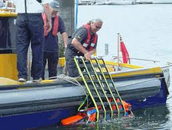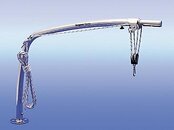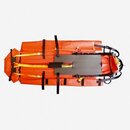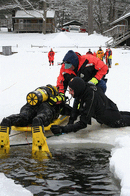I haven't taken a diver rescue course yet but backboards are always good to have and definitely could be used to evacuate an unconscious diver from the water. I suspect it would also be easier than without. loading may be tricky but if you're not already rescue breathing it wouldn't take much extra time and the diver could be secured to the board once back on the boat.
You are using an out of date browser. It may not display this or other websites correctly.
You should upgrade or use an alternative browser.
You should upgrade or use an alternative browser.
Would this work in a rescue situation?
- Thread starter Oldbear
- Start date
Please register or login
Welcome to ScubaBoard, the world's largest scuba diving community. Registration is not required to read the forums, but we encourage you to join. Joining has its benefits and enables you to participate in the discussions.
Benefits of registering include
- Ability to post and comment on topics and discussions.
- A Free photo gallery to share your dive photos with the world.
- You can make this box go away
Use the quickest and best method of extraction possible in your situation. By that I mean, a method that best protects and aids the victim, is done safely, timely and does not put the rescuer in harms way.
Backboards should be used when spinal injury is suspected, but is not necessarily the best method for a drowning or heart attack. The time it takes to retrieve and utilize the board can take precious time away from life saving CPR.
Everyone has given some very good alternative extraction methods, and there are probably another dozen out there. Ill throw in another way to get an unconscious diver out. A bowline is tied in a line and placed under the armpits and around the chest. Face the victim away from the boat. To pull them out, bounce, or dip, them up and down to gain momentum. On the up, pull extra hard and pop them right up on to the boat. This can easily be done with one or two people, allows rescuers to have good grip, allows for immediate support and immediately places them in a face up position for CPR once on deck.
Again, use the best extraction method you can for the situation. Not a bad idea to practice some of these methods now and again either.
Backboards should be used when spinal injury is suspected, but is not necessarily the best method for a drowning or heart attack. The time it takes to retrieve and utilize the board can take precious time away from life saving CPR.
Everyone has given some very good alternative extraction methods, and there are probably another dozen out there. Ill throw in another way to get an unconscious diver out. A bowline is tied in a line and placed under the armpits and around the chest. Face the victim away from the boat. To pull them out, bounce, or dip, them up and down to gain momentum. On the up, pull extra hard and pop them right up on to the boat. This can easily be done with one or two people, allows rescuers to have good grip, allows for immediate support and immediately places them in a face up position for CPR once on deck.
Again, use the best extraction method you can for the situation. Not a bad idea to practice some of these methods now and again either.
...A bowline is tied in a line and placed under the armpits and around the chest. Face the victim away from the boat. To pull them out, bounce, or dip, them up and down to gain momentum. On the up, pull extra hard and pop them right up on to the boat. This can easily be done with one or two people, allows rescuers to have good grip, allows for immediate support and immediately places them in a face up position for CPR once on deck.
Again, use the best extraction method you can for the situation. Not a bad idea to practice some of these methods now and again either.
This one would be easy to practice too. I also heard from our BSAC instructor, that our particular clud uses a net that they can slide under the victim and then roll him on board. We will be practicing this and a few other methods soon.
I am anxious to apply what I have learned.
Thanks all.
~ME~
Greetings,
I found this thread while researching information for a boat-based scuba rescue program I'm putting together. One of the key areas to be addressed is removing injured &/or unresponsive divers from the water to the boat. For this discussion, I will assume the dive vessel is of sufficient freeboard to necessitate a longer ( say 8 pairs of rungs in the ""T" style, allowing the diver to keep their fins on while climbing ) dive ladder. Here are my thoughts on the matter:
> What you do & how you do it will be directly related to the dive boat/platform you are using, and a host of other factors. "Stripping" the patient down to their thermal protection prior to ingress will be necessary ( I prefer "cutting through" the strapping as opposed to "unclipping," especially when dealing with "technical diving" configurations, and carry with me be both the "seat-belt cutter" style of tool as well as paramedic shears ).
> In the case of a diver who is responsive but is suspected of having a spinal injury, emphasis must be placed on SMR ( spinal motion restriction ) as best you can under the circumstances you're in; consider: the type of vessel used, the equipment available to you, the # of people able to assist, & the sea-state conditions. A rigid backboard with associative strapping ( including head movement restriction padding ) can be utilized if available, and the seas are co-operative. Two lines could be affixed to the hand-grip points at the head of the backboard, and the patient is pulled vertically up the dive ladder to a point where it can be man-handled to a horizontal position, then recovered to the deck of the vessel ( as an aside: if the backboard is of wooden or plastic construction, it can act as an effective insulator of electrical current on a metal deck, should a defibrillator be needed; remember to eliminate any accumulated standing water from beneath the patient prior to initiating a shock ). A marine davit with a 4-pt. bridle & "stokes ( personnel ) basket" is another possibility, but I would venture these options to be rare commodities in the offshore recreational dive boat realm.
> A more realistic option for the aforementioned diver, or an unresponsive diver, would be a rope ( preferably manila or sisal ) of sufficient length & thickness, with a rated snap-clip affixed securely to the end. The line is lowered to the patient & placed/cinched around the upper torso, below the armpits. If possible, a rescue diver of sufficient strength can position themselves below the patient's thighs & support them on their shoulders/upper arms, to assist surface personnel recover the patient up the ladder. If no rope is available, another option is for the rescue diver to maneuver the patient onto their lap, with the patient facing them, & their head resting on the rescuer's shoulder. The rescuer supports the patient under their arms, then assumes a posture where they "lean slightly outboard" to support & balance the patient's weight as best as they can. They then ascend the ladder with the patient cradled, to a point where the topside rescuers can take control of the patient. Suffice to say this technique would be very difficult to pull off. Unresponsive persons are "dead weight," and a wet patient would be slippery as an eel!
There are numerous examples of patients being hauled from the water using nothing but brute strength & as many 'hands-on" as was available ( by way of tragic example, read "The Last Dive" &/or "Shadow Divers," where the recovery of Chris & Chrissy Rouse is detailed ). People do what they have to do, as best as they can, in the circumstances given. Foresight & good preparation is key for the sake of the patient(s) & the rescuers. Always familiarize yourself with the vessel you will be diving from; ask yourself: "If things go bad, how will we handle it?" Part of your rumination should involve thinking through what is possible/available for recovering a diver back on to the boat.
Regards,
DSD
I found this thread while researching information for a boat-based scuba rescue program I'm putting together. One of the key areas to be addressed is removing injured &/or unresponsive divers from the water to the boat. For this discussion, I will assume the dive vessel is of sufficient freeboard to necessitate a longer ( say 8 pairs of rungs in the ""T" style, allowing the diver to keep their fins on while climbing ) dive ladder. Here are my thoughts on the matter:
> What you do & how you do it will be directly related to the dive boat/platform you are using, and a host of other factors. "Stripping" the patient down to their thermal protection prior to ingress will be necessary ( I prefer "cutting through" the strapping as opposed to "unclipping," especially when dealing with "technical diving" configurations, and carry with me be both the "seat-belt cutter" style of tool as well as paramedic shears ).
> In the case of a diver who is responsive but is suspected of having a spinal injury, emphasis must be placed on SMR ( spinal motion restriction ) as best you can under the circumstances you're in; consider: the type of vessel used, the equipment available to you, the # of people able to assist, & the sea-state conditions. A rigid backboard with associative strapping ( including head movement restriction padding ) can be utilized if available, and the seas are co-operative. Two lines could be affixed to the hand-grip points at the head of the backboard, and the patient is pulled vertically up the dive ladder to a point where it can be man-handled to a horizontal position, then recovered to the deck of the vessel ( as an aside: if the backboard is of wooden or plastic construction, it can act as an effective insulator of electrical current on a metal deck, should a defibrillator be needed; remember to eliminate any accumulated standing water from beneath the patient prior to initiating a shock ). A marine davit with a 4-pt. bridle & "stokes ( personnel ) basket" is another possibility, but I would venture these options to be rare commodities in the offshore recreational dive boat realm.
> A more realistic option for the aforementioned diver, or an unresponsive diver, would be a rope ( preferably manila or sisal ) of sufficient length & thickness, with a rated snap-clip affixed securely to the end. The line is lowered to the patient & placed/cinched around the upper torso, below the armpits. If possible, a rescue diver of sufficient strength can position themselves below the patient's thighs & support them on their shoulders/upper arms, to assist surface personnel recover the patient up the ladder. If no rope is available, another option is for the rescue diver to maneuver the patient onto their lap, with the patient facing them, & their head resting on the rescuer's shoulder. The rescuer supports the patient under their arms, then assumes a posture where they "lean slightly outboard" to support & balance the patient's weight as best as they can. They then ascend the ladder with the patient cradled, to a point where the topside rescuers can take control of the patient. Suffice to say this technique would be very difficult to pull off. Unresponsive persons are "dead weight," and a wet patient would be slippery as an eel!
There are numerous examples of patients being hauled from the water using nothing but brute strength & as many 'hands-on" as was available ( by way of tragic example, read "The Last Dive" &/or "Shadow Divers," where the recovery of Chris & Chrissy Rouse is detailed ). People do what they have to do, as best as they can, in the circumstances given. Foresight & good preparation is key for the sake of the patient(s) & the rescuers. Always familiarize yourself with the vessel you will be diving from; ask yourself: "If things go bad, how will we handle it?" Part of your rumination should involve thinking through what is possible/available for recovering a diver back on to the boat.
Regards,
DSD
Our club has had several discussions about what equipment we could add that would allow a minimal crew to better get an unconscious diver on board. For instance 2 divers and a skipper where the incapacitated diver is a big, heavy guy and the 2nd diver & skipper are small-sized women. What can we do to make this possible, short of adding a crane and winch?
We have no swim platform, just ladder you climb with your fins on and wide, solid railings on either side in the back to help you get up and over the back edge of the boat. A railing surrounds the entire (10m) boat, except of course at the ladder. The wheelhouse (small, rear from centre) does have some railing on top too if that's any help.
Referrals to videos are welcome.
We have no swim platform, just ladder you climb with your fins on and wide, solid railings on either side in the back to help you get up and over the back edge of the boat. A railing surrounds the entire (10m) boat, except of course at the ladder. The wheelhouse (small, rear from centre) does have some railing on top too if that's any help.
Referrals to videos are welcome.
Hello FinnMom,
One option that might address your scenario is a type of patient "roll-up" device. The one I'm familiar with is used on our F.D. rescue boats. It consists of a flexible, plastic webbing that is deployed off the side of the vessel; the patient is moved into position, then topside personnel pull/roll the person up:

You'd likely need to use a couple of hauling lines, & take a turn or two around the opposing rail, then you & your partner could haul in unison, putting your legs & back into it.
You could also investigate a Stowable Davit / Bridle & Stokes Basket ( or some form of collapsible litter ) that could be adapted to your vessel.


Or, as Chief Brody once said: "I think we're gonna need a bigger boat!"
Regards,
DSD
One option that might address your scenario is a type of patient "roll-up" device. The one I'm familiar with is used on our F.D. rescue boats. It consists of a flexible, plastic webbing that is deployed off the side of the vessel; the patient is moved into position, then topside personnel pull/roll the person up:

You'd likely need to use a couple of hauling lines, & take a turn or two around the opposing rail, then you & your partner could haul in unison, putting your legs & back into it.
You could also investigate a Stowable Davit / Bridle & Stokes Basket ( or some form of collapsible litter ) that could be adapted to your vessel.


Or, as Chief Brody once said: "I think we're gonna need a bigger boat!"
Regards,
DSD
Six Feet Under
Contributor
If getting the person on the board (and subsequently out of the water) makes it easier and quicker to start CPR, then that should take priority over spinal injuries. As a first responder (LEO), we were trained not to move people with possible spinal injuries or head injuries unless they needed to be removed from the area/vehicle quickly, IE vehicle fire, vehicle in the water sinking, other hazards and/or not currently breathing. I assisted with a crash a few weeks ago where the guy hit a tree doing about 60mph and rolled his car while hanging out the sunroof, drunk. He was not a pretty sight when I arrived on scene, half hanging out the sunroof like a rag doll... but you can't breathe with a car laying on your head, so obviously the car had to be rolled off of him and he had to be moved. We try to wait for the fire department or EMS if people are not in danger and can be stabilized until their arrival, but airway takes priority.
I would think if you had a neutrally buoyant backboard that you could get under said victim in the water, it wouldn't be hard to strap them in and then pull them up on the boat, depending on how high the sidewalls are.
All depends on the situation... that said, this is coming from someone who hasn't taken any rescue diver classes, just several first responder classes.
I would think if you had a neutrally buoyant backboard that you could get under said victim in the water, it wouldn't be hard to strap them in and then pull them up on the boat, depending on how high the sidewalls are.
All depends on the situation... that said, this is coming from someone who hasn't taken any rescue diver classes, just several first responder classes.
- Messages
- 7,660
- Reaction score
- 4,717
- # of dives
- 200 - 499
Just saw this thread. Not a bad idea, Oldbear! Maybe try one of these, but contact these people for suitability first:MARSARS Water and Ice Rescue Systems
Here is a pic of it being used. Me on the ice getting trained in its use.

(we all know that this thread is ancient, but I still like the idea...)
Here is a pic of it being used. Me on the ice getting trained in its use.

(we all know that this thread is ancient, but I still like the idea...)
Thanks for the suggestions!
The roll up looks like a good idea, esp. for the scenario of a big guy in the water and a couple persons of much lighter build and strength on the boat.
The ice sled looks like a nice exit option even for a healthy diver
Under the ice the situation is aided in that you have a rope on the diver anyway and the exit surface is flat right at the water's edge. I have read that some folks in the UK dive with a rope on one diver and a buddy line between the divers. I was taught and I believe our (i.e. The Finnish) Divers Federation specifies that there should be a separate rope and tender for each diver. It's good too in that a diver in a buddy pair has a buddy underwater and a tender on the end of his rope. Diving with just a rope and tender is fine too according to the federation's recommendations and is common practice.
The roll up looks like a good idea, esp. for the scenario of a big guy in the water and a couple persons of much lighter build and strength on the boat.
The ice sled looks like a nice exit option even for a healthy diver
Under the ice the situation is aided in that you have a rope on the diver anyway and the exit surface is flat right at the water's edge. I have read that some folks in the UK dive with a rope on one diver and a buddy line between the divers. I was taught and I believe our (i.e. The Finnish) Divers Federation specifies that there should be a separate rope and tender for each diver. It's good too in that a diver in a buddy pair has a buddy underwater and a tender on the end of his rope. Diving with just a rope and tender is fine too according to the federation's recommendations and is common practice.
flots am
Contributor
- Messages
- 3,226
- Reaction score
- 1,859
- # of dives
- I just don't log dives
A backboard is used to remove a diver/swimmer from the water when there is a suspected spinal injury. It takes at least two, but preferably more rescuers to stabilize the victim's spine, strap them to the board and then lift the victim and board from the water.
Backboards were removed from my most recent first-aid training because they were causing damage when strapping the non-flat victim onto the flat board.
flots.
Similar threads
- Replies
- 38
- Views
- 1,970
- Replies
- 0
- Views
- 283
- Replies
- 2
- Views
- 524
- Replies
- 1
- Views
- 959




